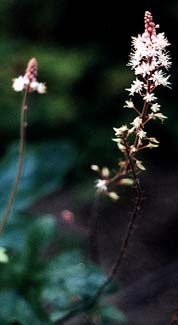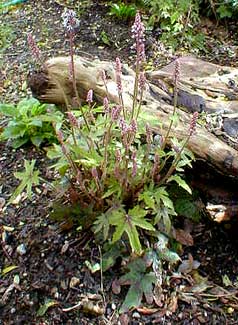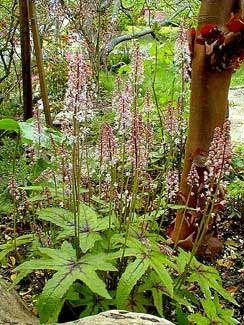
'Pink Bouquet'
Tiarella, or Foamflower
"Flowers grow out of dark moments."
-Corita Kent,
1918-1986
1918-1986
The first photo taken late in August 2002 is the fragrant flower-spike of Tiarella x 'Pink Bouquet' which we have growing underneath the Paperbark Maple along with other shade plants such as Jack-in-the-Pulpits & Himilayan May-apples.
The second photo was taken in March 2003. By the beginning of March it sends up the tall flower stems with buds, & then by mid-March begins to produce new leaves, shown in the photo still a bit shy of maturity. By the end of March & then gung-ho in April, the flower buds open into fluffy pyramidal "foamflowers."
The third photo shows the same clump in April. It blooms the rest of spring, with a solid rebloom in autumn, & can even bloom through summer if not too heat-stressed. At the height of its ornate leafy beauty it is such an impressive perennial, but it must be admitted that insects rather like it, while it rather dislikes heat or an even momentary dryness, so that it is at its peak of beauty mainly in spring.
 'Pink Bouquet' is one of just scads of hybrids developed by Don Heims of Terra Nova Nurseries in Oregon. I don't know the precise cross he has used for 'Pink Bouquet,' but many of his hybrids (including 'Dark Star' discussed on its own page) got started with T. cordifolia (Alleghany Foamflower) crossed with a Pacific Northwest species, T. trifoliata var. laciniata, the latter lending an especially redolent & flowerful aspect to the garden varieties.
'Pink Bouquet' is one of just scads of hybrids developed by Don Heims of Terra Nova Nurseries in Oregon. I don't know the precise cross he has used for 'Pink Bouquet,' but many of his hybrids (including 'Dark Star' discussed on its own page) got started with T. cordifolia (Alleghany Foamflower) crossed with a Pacific Northwest species, T. trifoliata var. laciniata, the latter lending an especially redolent & flowerful aspect to the garden varieties. 'Pink Bouquet' forms a restrained compact foot-tall mound of maple-like leaves with a maroon heart. In March it sends up its stems with tiny pink buds that burst open, for April or May, into sprays of pink & white flowers forming little upright pyramids. Rebloom occurs right up to August. The leaves are semi-evergreen through winter, though very beaten up by January or February when a good trim-back to make room for new leaves is advisable even if not necessary.
 Mr. Heims has done about as much as anyone in the world to increase the popularity of tiarellas, promoting his own hybrids & those of Sinclair Adams & a few other breeders. His work is hugely appreciated.
Mr. Heims has done about as much as anyone in the world to increase the popularity of tiarellas, promoting his own hybrids & those of Sinclair Adams & a few other breeders. His work is hugely appreciated.Still, to get picky, the majority of the new vast array of hybrids tend to have the same flower not particularly distinct one cultivar to the next. The leaves have more distinction than the flowers per se, though even these differences are too subtle for quite so many cultivars to be sensible.
Doubtless in years to come the majority of the varieties lately being introduced hand over fist will be permitted to die out, with just a few especially grand ones preserved long into the future. They're all nice, but with a few unusual exceptions they are just not very different one to the next, & hybridizing for no better reason than because it's easy is insufficient cause.
This sameness of three-fourths of the varieties aside, the genus Tiarella constitutes one of the truly finest & as yet still under-ultilized shade plants. It is bound to become increasingly popular thanks to the efforts of Mr. Heims & a couple hybridizers following in his path. When a shake-out occurs a few years from now, the best of his creations will become garden standards, as will be true also of the best of his "Heucherellas" which are Heuchera-Tiarella hybrids that look mostly like Heucheras.